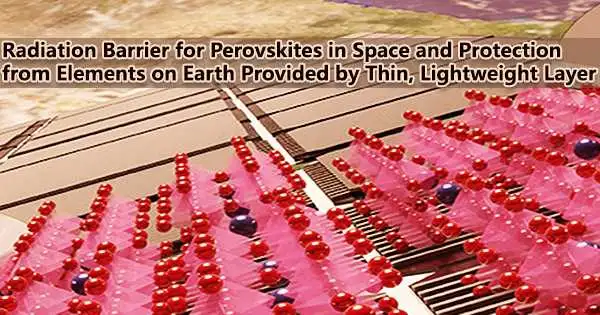According to recently published research from the National Renewable Energy Laboratory (NREL) of the U.S. Department of Energy, an ultrathin protective layer shows to be sufficient to shield a perovskite solar cell from the damaging impacts of space and harden it against environmental variables on Earth.
Funded by the U.S. Department of Defense’s Operational Energy Capability Improvement Fund (OECIF), the NREL research was done for the Air Force Research Laboratory (AFRL) to develop low-cost innovative energy sources for powering the armed forces worldwide.
The study is the most recent attempt to assess perovskites’ suitability for usage in space applications, where they would be subjected to protons, alpha particles, atomic oxygen, and other stresses.
Perovskites have the potential to achieve efficiencies comparable to those of present space PV technologies, making them an appealing alternative to other technologies for power generation in space.
Just as on Earth, perovskite solar cells need to have suitable durability. The environment in space is very different, though. While the weather poses the greatest hurdles on Earth, perovskites in space must deal with issues brought on by radiation bombardment and sharp temperature changes. More testing needs to be done, but perovskites appear to be more radiation-tolerant than many other solar cells.
In order to show how exposure to radiation in space may impact perovskites, researchers ran simulations last year. They found that the most recent technology would function in space but noted that the cell needed to be enclosed in some fashion to offer further security.
In the follow-up research, Ahmad Kirmani, lead author of the latest Nature Energy paper, said simulations demonstrated a micron-thick layer of silicon oxide would preserve the efficiency and increase the lifetime of perovskite solar cells in space. As a comparison, the micron-thick layer is about 100 times thinner than typical human hair.
Power conversion efficiency and operational stability of perovskite solar cells have been the two primary focus areas for the community so far. We have made a lot of progress and I think we have come far to the point that we might be pretty close to hitting those targets needed for industrialization. However, to really enable this market entry, the packaging is the next target.
Ahmad Kirmani
Kirmani said, “the silicon oxide layer could reduce the weight of conventional radiation barriers used for other solar cells by more than 99% and serves as a first step toward designing lightweight and low-cost packaging for perovskites.”
High-energy protons travel through perovskite solar cells without causing much harm. However, low-energy protons are more prevalent in space and do more damage to perovskite cells by dislodging atoms and slowly reducing efficiency levels. The inclusion of the silicon oxide layer shielded the perovskite from damage even from the low-energy protons, whose interactions with matter are much more easily than those of higher-energy protons.
“We thought it would be impossible for the silicon oxide to provide protection against fully penetrating long-range particles such as the high-energy protons and alpha particles,” Kirmani said. “However, the oxide layer turned out to be a surprisingly good barrier against those as well.”
The results are detailed in the paper “Metal oxide barrier layers for terrestrial and space perovskite photovoltaics.” The co-authors are David Ostrowski, Kaitlyn VanSant, Rosemary Bramante, Karen Heinselman, Jinhui Tong, Bart Stevens, William Nemeth, Kai Zhu, and Joseph Luther, from NREL; and several key collaborators who work with the team from the University of North Texas and the University of Oklahoma. VanSant holds the unique position of being a postdoctoral researcher at NASA who conducts research at NREL.
Unprotected perovskite solar cells lost only 15% of their initial efficiency when exposed to a stream of low-energy protons, the researchers discovered. The cells were destroyed by a higher particle concentration, while the shielded perovskites showed what the researchers called “a remarkable resilience.” With the simple barrier, the cells showed no damage.
The researchers examined how the barrier might be useful in more traditional applications in addition to making the cells more durable in space. The perovskite solar cells were then left in an uncontrolled environment of temperature and moisture for a number of days to simulate storage conditions.
The protected cells retained their initial 19% efficiency, while the unprotected cells showed significant degradation, from 19.4% to 10.8%. When other perovskite compositions, which are normally more moisture-sensitive, were exposed to water, the oxide layer also offered protection.
The perovskite solar cells were additionally put through a test chamber where they were pounded with ultraviolet photons akin to the conditions in low-Earth orbit. The photons interacted with oxygen to create atomic oxygen. The unprotected cells were destroyed after eight minutes. The protected cells retained their initial efficiency after 20 minutes and only had a slight drop after 30 minutes.
The results of the simulations and testing showed that the lifetime of the shielded solar cells used in Earth’s orbits and deep space would be enhanced from months to years by lowering the radiation damage.
“Power conversion efficiency and operational stability of perovskite solar cells have been the two primary focus areas for the community so far,” he said. “We have made a lot of progress and I think we have come far to the point that we might be pretty close to hitting those targets needed for industrialization. However, to really enable this market entry, packaging is the next target.”
The burgeoning technology, along with the protective layer of silicon oxide, enables its usage for a variety of terrestrial applications, such as powering drones. Perovskite solar cells may be placed onto a flexible substrate.
NREL is the U.S. Department of Energy’s primary national laboratory for renewable energy and energy efficiency research and development. NREL is operated for DOE by the Alliance for Sustainable Energy LLC.





